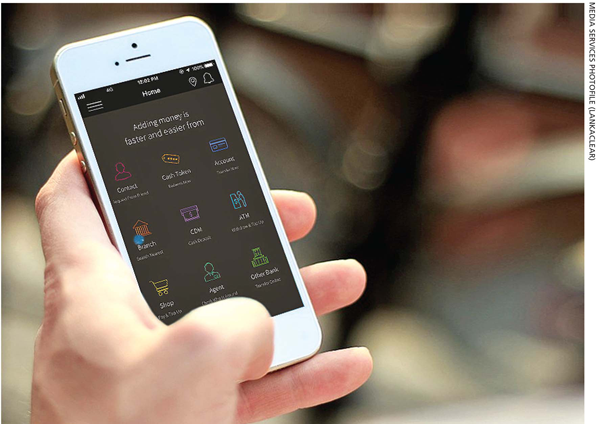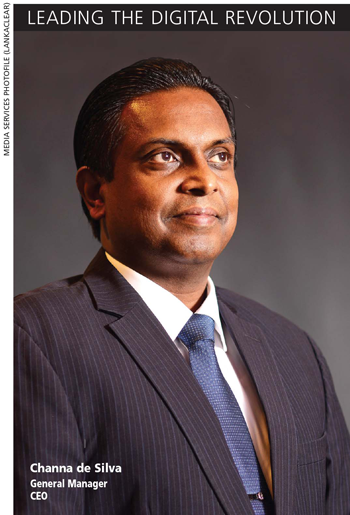LANKACLEAR
Q: Could you provide a brief overview of JustPay?
A: JustPay is a new payment mode that enables customers to make payments by transferring funds from their bank accounts to accounts in different banks through a debit transfer using their smartphones. This system is facilitated through our interbank real-time payment switch.
Q: What motivated LankaClear to pursue this initiative?
A: We studied payment related statistics such as the Central Bank of Sri Lanka’s (CBSL) Payments Bulletin as well as global statistics to determine where the industry should be heading.
Traditionally, the banking and financial services industry has been geared towards lending and deposits. But globally, the industry is moving towards transaction banking and payments, which has given rise to a plethora of fintechs and other innovations.
In Sri Lanka however, cash is still the most popular method of payment for retail transactions, followed by cheques and other modes.
A significant problem with this affinity for cash is the economic cost involved in maintaining and sustaining its use, in terms of circulation through printing, distribution, recycling and security. For instance, it has to be physically transported and distributed to different parts of the country, which includes substantial transport and security costs.
Surveys conducted by different international organisations indicate that in an economy such as ours, the use of cash costs approximately 1.5 percent of GDP. To put this in context, total government expenditure on education in Sri Lanka amounted to only 2.8 percent of GDP in 2017.
If we can reduce the cost of cash in circulation, the savings would go straight to the economy’s bottom line.
Q: What are the alternatives to cash that have been introduced over the years?
A: One of the primary alternatives during the last two decades was the introduction of debit cards. Payments were to be made through card based transactions using POS terminals rather than withdrawing cash at ATMs and then paying for goods and services.
According to CBSL statistics, banks have issued over 20.4 million debit cards and 1.6 million credit cards.
If you consider the statistics released by banks especially during Christmas, and the Sinhalese and Tamil New Year, ATM cash transactions have increased exponentially. This implies that more cards are being used as instruments for cash withdrawals rather than payments.
In fact, based on these statistics, it is estimated that the average card transactions for a POS terminal is less than five a day, which is unacceptably low.
Q: Why aren’t retail card based transactions more popular?
A: The low penetration of POS terminals across all merchants is an obvious reason. A major deterrent is the need for the devices to be physically present at their end. It would be cost prohibitive to locate a POS terminal in all outlets given the low average volume of transactions per merchant.
In addition, merchants may be unwilling to accept card payments as they’re charged a commission or Merchant Discount Rate (MDR) by banks, which amounts to two to three percent of the transaction value on average. This has been a major obstacle especially for small merchants who aren’t garnering sizable profits from the goods they sell. Most merchants tend to charge this commission from customers, which is a deterrent to using cards.
Finally, customers are not accustomed to using cards at POS terminals. When ATMs were rolled out initially, people would still go to the counter. However, over the next decade or so, people began to use them due to the convenience they offered.
We’re yet to witness this phenomenon for POS transactions at a pace that could rapidly increase the number of card transactions.
When addressing these obstacles, an option that we considered was a system that wouldn’t require investment at the merchant’s end but would need some devices and activity from customers.
Since we were aware that implementing this system would be a journey in itself, we looked at the early adopters of these electronic payments. And we realised that it would simply be current smartphone users – and we merely had to figure out how to enable them to make payments.
Q: So how did you look to achieve this?
A: The model that we pursued required customers to have smartphones but merchants only needed a simple feature phone to receive an SMS. We thought that this channel would lead to less friction at the merchant’s end.
We also understood the need to make the process easy or else customers wouldn’t use it. For instance, mobile channels such as e-wallets have been introduced over the years. A problem that we identified with this was the need to top it up through an agent or other means. When you make something more difficult to use than cash, customers will always prefer to use the latter. Therefore, we looked at the total banking population – the 20 million plus debit cards that are issued against bank accounts. We’ve already enabled a channel to facilitate real-time fund transfers from one bank account to another so we looked at how to use this to make payments utilising a smartphone.
Since it’s unlikely that customers and merchants maintain accounts at the same bank, a process was needed to send money from one bank to another.
Q: How do apps using JustPay operate?
A: The fintech apps will sign up merchants and customers.
Each merchant has to maintain an account with the bank, working with the fintech. But the app’s customers can maintain accounts at any bank. Customers can register using their bank account credentials through a onetime registration process. When they make payments following registering, funds are transferred from their account to the merchant’s through a real-time debit transfer.
This enables fintechs to partner with a single bank – even the smallest of banks – and cater to the entire banking population.
In addition to addressing the problem of enabling seamless payments, we also looked into addressing the transaction cost issue. Accordingly, we collaborated with the banks and arrived at a common understanding to reduce the MDR to about half a percent on each transaction. Subsequently, we obtained CBSL clearance for this new mode of payment.
This reduction should encourage merchants to accept electronic payments, leading to an increase in sales volumes, thus enabling them to earn more profits. Meanwhile, banks would benefit from an exponential increase in transaction volumes.
Q: And how have these apps performed in the market?
A: The first fintech app went live with JustPay in January last year. Statistics for the second half of 2018 indicate that transaction volumes grew by 40 times while the total value of transactions grew by a multiple of 50. This phenomenal growth has continued on a month on month basis, which is an endorsement of the new concept’s success.
However, one of the problems that we have encountered is with the process to validate customers’ identities, which is done through an SMS sent by their own banks. Receiving a random value from the banks through SMS and using this to register for JustPay is a mandatory requirement of the process. This is sent by banks only to customers’ registered mobile numbers.
We found that most customers haven’t registered for SMS alerts for their banking transactions. Unless they have, the registration process breaks down. But we’ve observed an increase in customers registering for SMS alerts lately to use JustPay.
Despite this bottleneck, 10 banks, six payment apps and three mobile wallets have already gone live with JustPay. The live payment apps are UPay, iPay, DirectPay, OrelPay, Dialog Genie and Sampath PayApp, while eZ Cash, mCash and FriMi are the mobile wallets. A few more are in the pipeline.
We expect this to gain traction as people will see the value in a seamless payment process
that does not require customers to have cards, nor for merchants to have POS terminals. Some apps have provided unbelievable offers to entice potential customers to register. A few more popular apps have yet to join JustPay but we believe that it’s only a matter of time.
Q: How does JustPay intend to address peer-to-peer payments?
A: We have tried to address this through another mechanism of JustPay that will enable people to transfer funds to friends and other parties.
Some telecommunication service providers’ apps that are in the market haven’t gained the required traction as both the sender and receiver have to maintain the same platform. Moreover, when withdrawing received funds, customers face difficulties and limitations in how they can be utilised. Because of these issues, these peer-to-peer apps have not generated the same level of transactions over the years.
Therefore, we looked to introduce a simple mechanism that would enable people to transfer funds from one bank account to another and implemented a new system called Payment Exchange Name (PEN). Unique nicknames (PENs) will be assigned to each bank account, which will enable people to transfer money using the receiver’s mobile number and PEN rather than bank account credentials.
We anticipate that this will also facilitate small merchant payments – such as grocery stores, Laundromats or even merchants at Sunday fairs – as they’d only have personal bank accounts so customers would be able to make peer-to-peer payments.
This system is currently in its pilot phase and we expect a few apps to go live with PEN early in the year.
The third phase is CBSL’s standardised Lanka QR code rollout. A QR sticker can be pasted on the merchant’s end, which will contain the information required by customers. A customer would simply need to scan the Lanka QR code and make a payment.
Q: What security measures are in place?
A: Most of these apps have security features such as biometric based authentication mechanisms (fingerprint or retinal scan). Smartphones also have PIN codes – i.e. the secondary security mechanism – so even if people misplace their phones, they have the capability to delete the data remotely.
We have also implemented a system to issue a digital certificate to each JustPay enabled phone to be used to digitally sign transactions and facilitate encryption.
Moreover, as customers and merchants receive SMS alerts regarding transactions in real time, they will be alerted about fraudulent or unauthorised transactions so they can notify their banks immediately.
Currently, there is a maximum per transaction limit of Rs. 10,000 for JustPay, which may be increased based on customer demand. This limit was implemented not necessarily for security reasons but primarily based on our research of ATM withdrawals, which revealed that over 80 percent of cash withdrawals are below this amount.
This obviously means that an even larger share of retail cash payments is below this limit.
Q: And what do you expect to see in terms of the use of JustPay in the future?
A: We’ve recently rolled out a system that enables fintechs to partner with a single bank and cater to the entire banking population, creating an enabling environment for businesses wherein merchants can facilitate electronic payments with minimal requirements from their end. Now it is up to the fintech community to take this forward and we will merely play a facilitating role.
At the moment, traction has primarily been in and around Colombo but we have witnessed the introduction of one app in Kandy. Many apps in the market could potentially use this system.
We feel that most of the building blocks are in place and in a relatively short time, more customers will demand seamless mobile payment options, which would facilitate innovation and the introduction of new business models.
Therefore, we anticipate that many new systems will evolve around providing convenience, encouraging more people to embrace them in turn.
Channa de Silva
General Manager
CEO
Telephone 2356900
Email info@lankaclear.com
Website www.lankaclear.com





